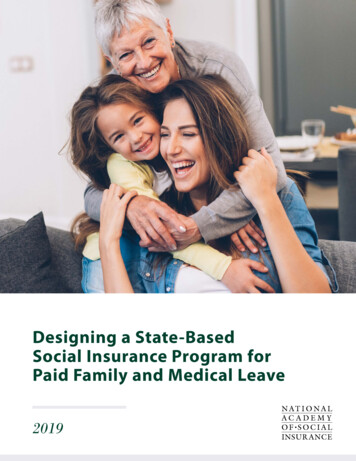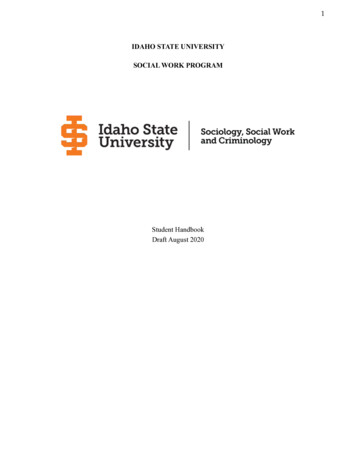
Transcription
Designing a State-BasedSocial Insurance Program forPaid Family and Medical Leave2019
PrefaceABOUT THE CHAPTERThis chapter explores policy options for states seekingto develop a paid family and medical leave program.It was developed during a year of deliberations bya Working Group of 13 experts on child and familypolicy, poverty and inequality, social policy, and taxlaw, representing a variety of perspectives and fieldsof expertise. It is part of a larger Study Panel projecton Universal Family Care. While addressed primarilyto state policymakers, the report may also interestfederal policymakers, administrators, and advocacyorganizations, as well as workers, families, businessowners, and others directly affected by the sometimescompeting needs to earn income and care forthemselves and/or their families.
Early Child Care and Education /Paid Family and Medical Leave Working GroupHeidi Hartmann*ChairPresident and CEO, Institute for Women’s Policy Research;Economist in Residence, American University; MacArthur FellowIndivar Dutta-Gupta* Co-Executive Director, Economic Security and Opportunity Initiative,Georgetown Center on Poverty and InequalityKathryn Edwards*Associate Economist, RAND Corporation;Professor, Pardee RAND Graduate SchoolJoan Entmacher*Senior Fellow, National Academy of Social InsuranceJocelyn FryeSenior Fellow, Center for American ProgressJeffrey Hayes*Program Director, Job Quality and Income Security, Institute for Women’s Policy ResearchElaine MaagPrincipal Research Associate, Urban-Brookings Tax Policy Center, The Urban InstituteAparna Mathur*Resident Scholar, Economic Policy, American Enterprise Institute;Co-Director, AEI-Brookings Project on Paid Family and Medical LeaveMichelle McCreadyChief of Policy, Child Care Aware of AmericaRay PepinTemporary Disability Insurance (TDI) Administrator,Rhode Island Department of Labor & TrainingErik RettigSenior Manager, SMB/Economic Policy, IntuitChristopher Ruhm*Professor of Public Policy and Economics, University of VirginiaMarci YbarraAssociate Professor, School of Social Service Administration, University of Chicago* Member, National Academy of Social Insurance Board Member, National Academy of Social Insurance70PAID FAMILY AND MEDICAL LEAVE
Project StaffBenjamin W. Veghte, Study Panel DirectorVice President for PolicyNational Academy of Social Insurance(until June 2018)Caregiving Policy ConsultantNational Academy of Social Insurance(July 2018 – June 2019)Alexandra L. BradleyLead Policy Analyst, Health and CaregivingNational Academy of Social Insurance(until November 2018)Caregiving Policy ConsultantNational Academy of Social Insurance(December 2018 – June 2019)Suggested CitationAlexandra L. Bradley, Benjamin W. Veghte, and Heidi Hartmann, “Designing a StateBased Social Insurance Program for Paid Family and Medical Leave,” in DesigningUniversal Family Care: State-Based Social Insurance Programs for Early Child Careand Education, Paid Family and Medical Leave, and Long-Term Services and Supports,eds. Benjamin W. Veghte, Alexandra L. Bradley, Marc Cohen, and Heidi Hartmann(Washington, DC: National Academy of Social Insurance, 2019).71
72PAID FAMILY AND MEDICAL LEAVE
TABLE OF CONTENTSPreface. 69Executive Summary. 75I.Introduction. 76II. The Landscape of Paid Family and Medical Leave Policies in the United States. 92III. Policy Options for State Paid Family and Medical Leave Programs. 108IV. Key Policy Design Elements and Considerations. 116V. Integration and Implementation Considerations. 126VI. Conclusion. 132
74PAID FAMILY AND MEDICAL LEAVE
EXECUTIVE SUMMARYAt some point during their lives, virtually allworkers will need time away from work tocare for a loved one and/or cope with a healthproblem of their own. While this need for timeoff is nearly universal, a significant share ofworkers in the United States currently lacksaccess to any kind of guaranteed leave toprovide or receive care. Thus, many workersare forced to choose between caring forthemselves or a loved one and losing wagesor even their job. Paid leave benefits are alsohighly inequitably distributed; workers whoearn more, work for large employers, or holdwhite-collar jobs are much more likely to haveaccess to paid family and/or medical leave.1. Universal, contributory social insuranceprogram, exclusive state fund—Throughouttheir careers, all workers contribute to astate social insurance fund—out of which allbenefits are paid—in return for an earnedbenefit should a PFML need arise.This chapter describes how, in the absence ofa national policy, states have stepped up ascritical leaders in advancing paid family andmedical leave (PFML) programs. To date, tenjurisdictions have adopted some form of paidleave policy (CA, CT, DC, HI, MA, NJ, NY, PR,RI, WA). The experiences of these states canoffer valuable lessons for future programs. Inparticular, states have learned the importanceof providing sufficient wage replacement ratesto permit lower-wage workers to actually usethe benefits, conducting robust educationand outreach campaigns to inform the publicabout the program, and simplifying theadministrative burden of applying for benefitsfor both applicants and administrators.3. Employer mandate—Employers areobligated to provide paid leave benefitsdirectly to their workers, either by selfinsuring or by purchasing private coverage.Next, the chapter discusses three policy optionsfor states interested in developing a paid familyand medical leave program:2. Contributory social insurance programwith regulated private options—Employersare required to offer a certain level and typeof coverage and to comply with specifiedanti-discrimination and other consumerprotections. Employers are free to choosebetween utilizing the state fund, self-insuring,and/ or purchasing a private plan for coverage.After choosing a model for the program,policymakers must determine other importantdesign features, including eligibility requirements,qualifying events, the definition of family,benefit design, and job protection. There are alsofactors surrounding program implementationand integration to consider, such as programadministration, education and outreach,evaluation, integration with other state policymechanisms, coordination with existingemployee benefit plans, and coverage for selfemployed workers. Ultimately, however, absent arobust national program, states can substantiallyimprove quality of life and financial security forworkers and their families by implementing welldesigned paid family and medical leave programs.75
Section I.INTRODUCTION
At some point during their lives, virtually allworkers will need time away from work tocare for a loved one and/or cope with a healthproblem of their own. While this need fortime off is nearly universal, a significant shareof workers in the United States currently lacksaccess to any kind of guaranteed leave toprovide or receive care, and particularly tothe types of financial support—such as wagereplacement—that would make such leavepossible. As a result, many workers are forcedto choose between caring for themselves or aloved one and losing wages or even their job.The current landscape of family and medicalleave policies in the United States leavessubstantial gaps in workplace supports forfamily caregiving and personal medicalneeds. The Family and Medical Leave Actof 1993 (FMLA) provides many U.S. workerswith access to unpaid, job-protected timeoff to provide or receive care. Under this law,a worker is eligible for 12 weeks of unpaidleave in the event of the birth, adoption,or foster placement of a child; the serioushealth condition of a close family member;a worker’s own serious health condition; orthe military deployment of a worker’s spouse,child, or parent.1 Family members of qualifiedveterans, reservists, and active duty militarypersonnel may also take up to 26 weeks ofleave from their jobs to care for the militarymember or veteran who is injured or ill underthe Military Caregiver Leave extension of theFMLA.2 This legislation undeniably markeda significant shift in U.S. work-family policy,but the coverage remains insufficient for asubstantial portion of the workforce. Due torestrictive eligibility requirements, roughly40 percent of workers are excluded entirelyFamily and Medical Leave Act of 1993, Pub. L. No. 103-3, 107 Stat. 6 (1993), -28.U.S. Department of Labor, Wage and Hour Division, “Fact Sheet #28M(b): Military Caregiver Leave for a Veteran under the Familyand Medical Leave Act,” n.d., pdf.12SECTION I. INTRODUCTION77
from FMLA coverage, and even those whoare covered often cannot afford time awayfrom work without any compensation. 3 Asmany families across the nation strugglewith economic insecurity, and as workersincreasingly juggle work and caregivingresponsibilities, paid family and medicalleave is being offered or discussed ina growing number of states and by anincreasing number of employers acrossthe country.The United States is the only industrializedcountry—and one of only a handful ofcountries across the world—without anational program offering workers someform of paid caregiving leave. Only 17percent of civilian workers have paidcaregiving leave coverage through anemployer-provided benefit. 4 Similarly, nonational policy provides or mandates thatworkers be paid for time off to address theirown health-related issues. Although paidsick leave is more common than paid familyleave, coverage remains far from universal:The U.S. is the only industrializedcountry with no national programoffering workers some form of paidcaregiving leave.among civilian workers, 74 percent haveaccess to paid sick leave, 5 39 percent haveaccess to short-term disability insurancebenefits, and 34 percent have access tolong-term disability insurance. 6 Accessto paid leave benefits is also unequallydistributed across the workforce. Only 8percent of the lowest-earning quartile hasaccess to paid family leave,7 and only 19percent has access to short-term disabilityinsurance;8 for workers in the highestearning quartile, those numbers jump to28 percent 9 and 54 percent,10 respectively.Coverage also varies by employer size: thelarger the employer, the more likely itsemployees are to have access to paid familyleave11 and temporary disability insurance.12Jacob Alex Klerman, Kelly Daley, and Alyssa Pozniak, “Family and Medical Leave in 2012: Technical Report,” Cambridge, MA: AbtAssociates, Revised April 2014, echnical-Report.pdf.4Bureau of Labor Statistics, “Table 32. Leave Benefits: Access, Civilian Workers, March 2018,” U.S. Department of Labor, ership/civilian/table32a.htm.5Ibid.6Bureau of Labor Statistics, “Table 16. Insurance Benefits: Access, Participation, and Take-Up Rates, Civilian Workers, March 2018,”U.S. Department of Labor, 2019, p/civilian/table16a.htm.7Bureau of Labor Statistics, “Table 32. Leave Benefits: Access, Civilian Workers, March 2018,” U.S. Department of Labor, ership/civilian/table32a.htm.8Bureau of Labor Statistics, “Table 16. Insurance Benefits: Access, Participation, and Take-Up Rates, Civilian Workers, March 2018,”U.S. Department of Labor, 2019, p/civilian/table16a.htm.9Bureau of Labor Statistics, “Table 32. Leave Benefits: Access, Civilian Workers, March 2018,” U.S. Department of Labor, ership/civilian/table32a.htm.10Bureau of Labor Statistics, “Table 16. Insurance Benefits: Access, Participation, and Take-Up Rates, Civilian Workers, March2018,” U.S. Department of Labor, 2019, p/civilian/table16a.htm.11Bureau of Labor Statistics, “Table 32. Leave Benefits: Access, Civilian Workers, March 2018,” U.S. Department of Labor, ership/civilian/table32a.htm.12Bureau of Labor Statistics, “Table 16. Insurance Benefits: Access, Participation, and Take-Up Rates, Civilian Workers, March2018,” U.S. Department of Labor, 2019, p/civilian/table16a.htm.378PAID FAMILY AND MEDICAL LEAVE
Occupational disparities exist as well. Forexample, nearly 1 in 3 workers in the fieldsof finance and management have access toemployer-provided paid family leave, whilethat proportion is closer to 1 in 20 for workersin the construction and hospitality industries(see Figure 1).13Proposals to implement universal paid familyand medical leave programs have beengaining traction at both the state and federallevel. Paid family and medical leave refersto a program that incorporates both paidmedical leave—also known as temporaryor short-term disability insurance—andpaid family leave—where workers can taketime to provide care for a family memberor loved one. (See text box on p. 91: PaidLeave Terminology.) Although this reportchapter focuses on options for state-levelpaid leave policies, many of the issuesdiscussed are also integral to the design of afederal paid leave policy. Several states havealready implemented their own paid familyand medical leave programs (see SectionII of this chapter), and others are startingup or passing new laws that establish suchprograms. A number of employers are alsovoluntarily offering paid leave to employees,(see text box on p. 90: Employer-ProvidedPaid Family and Medical Leave) althoughlow-wage workers frequently receive little orno benefit under these programs. Limitingpaid leave to full-time or higher-earningFIGURE 1: Employer-Provided Paid Leave Benefits: Civilian WorkersPaid family leavePaid sick leave1050to99worke0trso499workers500 les,OiceShort-term 0%20%10%0%Long-term disabilitySource: Bureau of Labor Statistics, “Table 32. Leave benefits: Access, civilian workers, March 2018,” U.S. Department of Labor, 2019, p/civilian/table32a.htm; Bureau of Labor Statistics, “Table 16. Insurance benefits: Access,participation, and take-up rates, civilian workers, March 2018,” U.S. Department of Labor, 2019, p/civilian/table16a.htm.Bureau of Labor Statistics, “Table 32. Leave Benefits: Access, Civilian Workers, March 2018,” U.S. Department of Labor, ership/civilian/table32a.htm.13SECTION I. INTRODUCTION79
employees may exclude those who need thebenefit the most; workers with the greatestneed—such as people with disabilities14 ormothers with young children15—are more likelyto hold part-time and/or lower-wage positions.A universal program offers a promisingavenue for workers to access these criticalbenefits regardless of their income,industry, job title, gender, or familycomposition. But programs must becarefully designed to ensure that policychoices do not unduly or unwittinglyexclude many of the workers most in needof protection and coverage.This chapter describes the variety ofdesign options available to policymakersconsidering a paid leave policy and discussesthe effects of different options on the equity,efficiency, affordability, and adequacy of anew (or updated) paid family and medicalleave program.Several states have implemented paidfamily and medical leave programs, andothers are starting up new programs.Kali Grant, T.J. Sutcliffe, Indivar Dutta-Gupta, and Casey Goldvale, “Security and Stability: Paid Family and Medical Leave and ItsImportance to People with Disabilities and Their Families,” Georgetown Center on Poverty and Inequality and The Arc, CreativeCommons, 2017, Paid-Leave-Report.pdf.15Women’s Bureau: U.S. Department of Labor, “Working Mothers Issue Brief,” 2016, https://www.dol.gov/wb/resources/WBWorkingMothers 508 FinalJune13.pdf.1480PAID FAMILY AND MEDICAL LEAVE
Paid Leave TerminologyPaid Family Leave provides workerswith paid time off to care for a loved one.Qualifying events typically include thebirth, adoption, or foster placement ofa child; the need to care for a loved onewith a serious health condition; and, insome cases, contingencies surroundingthe military deployment of a close familymember. Some employers voluntarily offerpaid family leave to some or all employeesand pay the costs of that coverage out ofpocket (i.e., self-insure). Several states havedeveloped family leave insurance programsfor workers, typically funded throughemployee payroll contributions.Paid Medical Leave (or Short-Termor Temporary Disability Insurance)compensates workers for lost wages in theevent of a longer-term health condition thatis not related to work. Common conditionsinclude pregnancy, long-term illness, orrecovery from a surgical procedure. Paidmedical leave typically provides partial wagereplacement for up to a designated numberof weeks, but some employers do offer totalwage replacement throughout the leaveperiod. Currently, coverage for paid medicalleave, including temporary disability insurance(TDI), may be funded either by a publicstate-level program or by private coveragepurchased by the employer or employee.Eligibility for benefits is typically determined bythe state administrative agency or private planprovider, which may limit employer influenceon the coverage decision and give workers aright to appeal benefit denials. Benefits oftenbegin after a brief waiting period (e.g., oneweek) and, in some cases, decrease over theduration of leave (i.e., workers may receive ahigh portion of wages for a designated period,followed by lower wage replacement forsubsequent days/weeks).In addition to paid family and medicalleave, there are several other ways in whichworkers can receive wage replacement andmedical benefits in case of inability to work forhealth reasons:Paid Sick Days provide workers with paid timeoff to address acute personal health or safetyneeds. Employers generally fund and managesick leave programs directly, either voluntarilyor as a result of a state- or local-level mandate.Particularly for state or locally mandatedprograms, employees can typically use paidsick days for short-term, non-work-relatedillnesses and injuries; medical appointments;and accessing services or care related todomestic violence, sexual assault or abuse, orstalking. Some programs and employer policiespermit workers to use paid sick days to attendto a family member with one of these acuteneeds. Workers typically accrue sick leavebased on hours worked, and employers usuallyimpose relatively strict limits on workers’ability to accrue sick days. Some employers,however, permit workers to accrue relativelyhigh numbers of sick days, sometimes allowingleave to be carried over from year to year. Thesemore generous benefits can support longerperiods of leave for serious health conditions orevents such as childbirth.Long-Term Disability Insurance provides cashbenefits in the event of an illness or injury that isexpected to impede a worker’s ability to remainSECTION I. INTRODUCTION81
gainfully employed, either permanently orfor a substantial period of time (i.e., years).In addition to the coverage available toall eligible workers through the SocialSecurity Disability Insurance program, someemployers offer private long-term disabilityinsurance coverage as a benefit, and someworkers purchase private coverage directly.Workers’ Compensation helps compensatefor lost wages and pays medical expensesassociated with an injury or illness thatoccurs on the job. Coverage is funded byemployers, except for three states whereThe Changing Nature of Work andFamily LifeThe dynamics of work and family life in theU.S. have changed substantially over thepast several decades, and national policy hasbeen slow to adapt to this shifting reality. Thevast majority of children are now growingup in households where every parent isworking,16 and nearly one in three childrenlives in a single-parent household.17 Womenalso now make up a substantial proportionof the workforce.18 Most of today’s familiesneed all parents’ earnings to make endsmeet; 64 percent of mothers bring in at leastemployers and employees contributetowards premium costs. Employerstypically decide whether to obtaincoverage through a private carrierplan, self-insuring, or a state Workers’Compensation insurance fund. Workers’Compensation coverage is required by lawin all states except Texas, where coverageis voluntary. While there is consistencyamong central features of Workers’Compensation programs, benefits, programadministration, eligibility requirements,and other program design features varytremendously across the country.The vast majority of children livein households where every parentis working.one quarter of family earnings, including 41percent who bring in half or more, and theproportional contributions of low-incomemothers and women of color to familyearnings are even higher.19Since the mid-20th century, the proportionof women in the workforce has increasedEileen Patten, “How American Parents Balance Work and Family Life When Both Work,” Pew Research Center, 2015, en-both-work/.17Authors’ calculations based on November 2017 data from the Current Population Survey, available at: U.S. Census Bureau,“Historical Families Tables, 2017, o/families/families.html.18Bureau of Labor Statistics, “Table 5. Employment Status of the Population by Sex, Marital Status, and Presence and Age of OwnChildren under 18, 2015-2016 Annual Averages,” U.S. Department of Labor, 2018, arah Jane Glynn, “Breadwinning Mothers Continue to be the U.S. Norm,” Center for American Progress, May 10, 2019, e-u-s-norm/.1682PAID FAMILY AND MEDICAL LEAVE
substantially, from roughly 34 percent in 1950to about 57 percent in 2015.20 At the sametime, women still often retain the primarycaregiving responsibilities for children, familymembers with disabilities and/or chronicillnesses, and aging family members.21 As aresult, working women often suffer stagnatedearnings, heightened barriers to professionalgrowth, and employer discrimination. Menare also—and increasingly—confrontingthe financial consequences of caregiving, asthey become more involved in providingcare, desire to spend more time withtheir children, 22 and face stigma in theworkplace. 23 As a result of these changingworkplace and gender dynamics, mostfamilies have no one to provide full-timecare for a child and/or family memberwhen needed. Without access to paid leave,family income and financial security sufferregardless of who takes time off to provideor receive care.Mitra Toossi and Teresa L. Morisi, “Women in the Workforce Before, During, and After the Great Recession,” U.S. Department ofLabor, Bureau of Labor Statistics, 2017, r-the-great-recession.pdf.21Richard Schulz and Jill Eden (Eds.), Families Caring for an Aging America, Committee on Family Caregiving for Older Adults; Board onHealth Care Services; Health and Medicine Division; National Academies of Sciences, Engineering, and Medicine (Washington, DC:National Academies Press, 2016), ookshelf NBK396401.pdf.22Kim Parker and Wendy Wang, “How Mothers and Fathers Spend Their Time,” Chapter 4 of Modern Parenthood: Roles of Moms andDads Converge as They Balance Work and Family (Washington, DC: Pew Research Center, 2013), tes/3/2013/03/FINAL modern parenthood 03-2013.pdf.23Joseph A. Vandello, Vanessa E. Hettinger, Jennifer K. Bosson, and Jasmine Siddiqi, “When Equal Isn’t Really Equal: TheMasculine Dilemma of Seeking Work Flexibility,” Journal of Social Issues, vol. 69, no. 2, 2013.20SECTION I. INTRODUCTION83
However, the need for caregiving has notdisappeared—and will not—simply becausethe number of stay-at-home caregivers hasdecreased. In fact, families are coping with avariety of care needs. Many modern familiesextend well beyond the scope of the “nuclear”household. Workers are providing care fora broad range of family members, fromspouses, children, and parents; to extendedfamily members such as grandparents,siblings, aunts, uncles, and cousins; to“chosen family” and others in their extendedcommunities.24 The Baby Boomer generationis also aging at a rapid pace, and the numberof caregivers available for each senior isin steady decline.25 As of 2010, there wereroughly seven potential caregivers (definedas people aged 45-64) for each person aged80 or older; that ratio is projected to drop to4:1 by 2030 and 3:1 by 2050.26 Roughly 1 in 6working adults is already providing care fora family member over the age of 65. Someadults leave the workforce altogether becausethey cannot manage the competing demandsRoughly 1 in 6 working adults isproviding care for a family member overage 65.of work and caregiving. Additionally, almosta quarter of these family eldercare providersalso have children.27 While family caregivingleave-taking currently comprises a smallerportion of FMLA claims than personal medicalleave (which accounts for over half of claims),family caregiving claims do not lag farbehind new child bonding claims (18 versus21 percent of claims in a given 12-monthperiod, respectively),28 demonstrating theimportance of covering caregiving beyondnew parenthood.Impact of Paid Leave on EconomicSecurity, Health, and Child DevelopmentResearch in the United States29 and acrossOECD nations 30 has found that access to paidJacqueline L. Angel and Richard A. Settersten, “What Changing American Families Mean for Aging Policies,” Public Policy &Aging Report, vol. 25, no. 3, 2015, doi: 10.1093/ppar/prv011.25Nina Dastur, Indivar Dutta-Gupta, Laura Tatum, Peter Edelman, Kali Grant, and Casey Goldvale, “Building the Caring Economy:Workforce Investments to Expand Access to Affordable, High-Quality Early and Long-Term Care,” Georgetown Center on Povertyand Inequality, Creative Commons, 2017, s/2017/05/Building-thecaring-economy hi-res.pdf.26Donald Redfoot, Lynn Feinberg, and Ari Houser, “The Aging of the Baby Boom and the Growing Care Gap: A Look at FutureDeclines in the Availability of Family Caregivers,” AARP Public Policy Institute, Insight on the Issues 85, 2013, ic policy gap-insight-AARP-ppi-ltc.pdf.27U.S. Department of Labor, Navigating the Demands of Work and Eldercare, (Washington, DC, 2016), http://digitalcommons.ilr.cornell.edu/key workplace/1602.28Jacob Alex Klerman, Kelly Daley, and Alyssa Pozniak, “Family and Medical Leave in 2012: Technical Report,” Abt Associates,2014, Technical-Report.pdf.29Charles L. Baum and Christopher J. Ruhm, “The Effects of Paid Family Leave in California on Labor Market Outcomes,” Journalof Policy Analysis and Management, vol. 35, no. 2, 2016; Nuno Mota, “Parental Leave Assistance and Long-Term Effects on FemaleLabor Supply,” 2015, loads/2014/09/NM Paid Leave 01-26-15.pdf.30Becky Pettit and Jennifer Hook, “The Structure of Women’s Employment in Comparative Perspective,” Social Forces, vol. 84, no. 2,2005; Jane Waldfogel, Higuchi Yoshio, and Abe Masahiro, “Family Leave Policies and Women’s Retention after Childbirth: Evidencefrom the United States, Britain, and Japan,” Journal of Population Economics, vol. 12, no. 4, 1999; WORLD Policy Analysis Center, “AReview of the Evidence on the Length of Paid Family and Medical Leave. Policy Brief,” 2018, nd%20Medical%20Leave.pdf.2484PAID FAMILY AND MEDICAL LEAVE
leave increases maternal workforceattachment after giving birth, reducespoverty for households with children,31and may also be associated with increasedearnings for mothers.32 Access to paidparental leave for new fathers has beendemonstrated to increase women’semployment33 and future earnings.34Paid medical leave can help workers withdisabilities avoid
1. Universal, contributory social insurance program, exclusive state fund—Throughout their careers, all workers contribute to a state social insurance fund—out of which all benefits are paid—in return for an earned benefit should a PFML need arise. 2. Contributory social insurance program with regulated private options—Employers










